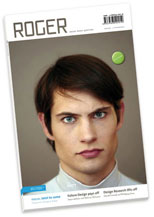
I'd say that as a general rule I'd like to hold onto my soul. Afterall, it might come in handy sometime, which is exactly why the title of this book intrigued me. "How to be a graphic designer, without losing your soul" by Adrian Shaughnessy is a great handbook for new designers, in or just out of college. It isn't about design itself, but rather about being a designer. Not about lines, and colors, and shapes, it's about finding creativity, dealing with clients, and most of the in's and out's of becoming a professional designer.
The information it covers seems so basic, but is genuinely useful; the kinds of things you can find tidbits of in magazine articles but almost never compiled in one place. Which direction to hold you portfolio in an interview, how to win clients: "by doing great work all of the time," and even a quick overview of how to keep track of your design company's finances. It covers all the little stuff, so you can stop worrying about business details and start doind what you do best, design!
But the book doesn't stop with just business, it's like a mullet: business in front, and pleasure in the back! In the last pages of the book there is a chapter covering the creative process. In short, how to pull the best designs possible out of yourself even if your brain is kicking and screaming for ideas. My favorite piece of advice: "It is only by daring to experiment, and by taking risks, that rich and meaningful design is created."

It's also sprinkled with interviews from array of modern designers, providing unique insights into the profession itself, such as the tidbit from Rudy VanderLans: "It's only natural to be revered by your peers." Haha, he knows me so well! But seriously, there is lots of good information to be gleaned.
Not only is the content good, but the deisgn of the book itself is good. The pages are carefully typeset, and all samples are printed 2-color in the prettiest color black, and cyan ink. Every little thing about it is worth admiring, even the new book smell! So dig your nose into the pages, read every word, and don't forget to take a whiff.
by Lou Smith
Buy "How to be a graphic designer, without losing your soul" by Adrian Shaughnessy on Amazon









